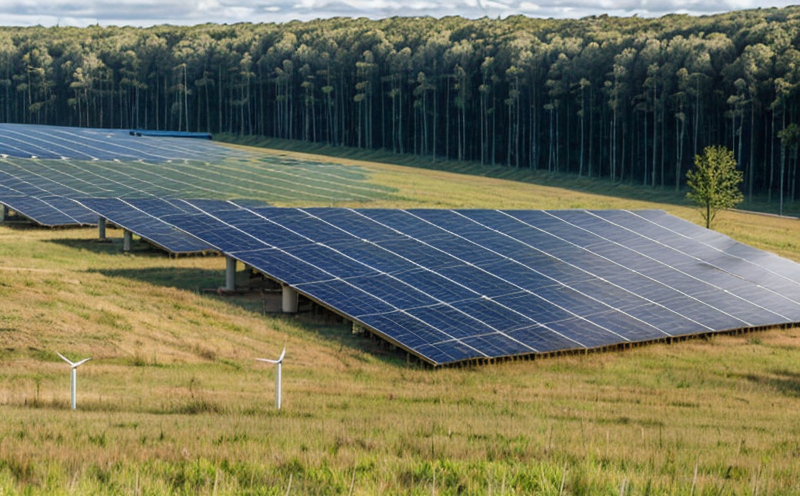ASTM E3400 Climate Impact Assessment of Renewable Energy Projects Test
The ASTM E3400 test method is a critical tool in the environmental impact assessment of renewable energy projects. It provides a standardized approach to evaluate the climate change impacts associated with renewable energy developments, ensuring that the project's lifecycle contributes positively to sustainability goals.
This test assesses the direct and indirect greenhouse gas (GHG) emissions from renewable energy installations throughout their operational lifespan. By quantifying these emissions, stakeholders can make informed decisions regarding technology selection, site optimization, and policy compliance. The ASTM E3400 test is particularly relevant for wind, solar, biomass, and hydroelectric projects.
The methodology follows the principles outlined in ISO 14067:2018 and EN ISO 14067:2018, which provide frameworks for GHG emissions accounting. The ASTM E3400 test integrates these standards to offer a robust assessment tool that aligns with international best practices.
The first step in the process is selecting an appropriate boundary for the project lifecycle. This includes not only operational emissions but also those associated with materials and construction processes. Once defined, the test method quantifies both direct (emissions from activities within the project boundaries) and indirect (emissions from third-party activities that support the project) GHG emissions.
A detailed analysis of raw material sourcing is essential for accurate emissions accounting. This includes assessing the carbon footprint of the materials used in manufacturing renewable energy components such as solar panels or wind turbine blades. The test method also considers embodied carbon, which refers to the CO2 released during the extraction, processing, and transport of these resources.
Operational emissions are a key focus of ASTM E3400. For example, in solar projects, this would include electricity used for plant maintenance and administrative activities. In wind projects, it encompasses the energy required for turbine operation and repair. The test method provides a structured approach to measure these emissions accurately.
The final step is calculating the net climate impact of the project by subtracting any positive impacts (e.g., carbon offset credits) from the total GHG emissions. This comprehensive assessment helps stakeholders understand the full environmental footprint of their renewable energy projects and identify areas for improvement.
| Step | Action | Outcome |
|---|---|---|
| Select Lifecycle Boundary | Determine project's GHG emissions scope | Define the scope of emissions to be assessed |
| Data Collection | Gather data on material sourcing, construction, and operation | Compile detailed emission inventories |
| Emission Quantification | Analyze direct and indirect GHG emissions | Determine the total climate impact of the project |
| Credit Analysis | Assess positive impacts, if any | Calculate net climate impact |
The ASTM E3400 test method is essential for compliance with regulatory requirements and voluntary sustainability initiatives. It ensures that renewable energy projects meet stringent environmental standards while contributing to global climate goals.
Benefits
- Regulatory Compliance: Ensures adherence to national and international emission regulations, such as the EU's Greenhouse Gas Emissions Trading System (EU ETS).
- Sustainability Reporting: Provides transparent data for sustainability reports, enhancing a company’s reputation.
- Informed Decision-Making: Guides strategic decisions on technology selection and operational optimization to reduce environmental impact.
- Risk Management: Identifies potential risks associated with high-emission processes early in the project lifecycle.
- Enhanced Reputation: Demonstrating a commitment to climate responsibility can attract investment and improve stakeholder relationships.
- Operational Efficiency: By identifying inefficient processes, projects can reduce costs through improved operational practices.
Eurolab Advantages
As a leading laboratory specializing in environmental testing, Eurolab offers unparalleled expertise and advanced instrumentation for ASTM E3400 compliance. Our team of certified experts ensures the highest standard of accuracy and reliability.
- Comprehensive Services: We provide full-service support from initial consultation to final report generation.
- Innovative Technology: Utilize state-of-the-art equipment for precise emission measurements.
- Expertise: Our team is well-versed in the latest testing methodologies and international standards.
- Compliance Assurance: Ensures that all tests meet or exceed regulatory requirements.
Our commitment to excellence, combined with our extensive experience in renewable energy projects, makes Eurolab the premier choice for ASTM E3400 testing services. Contact us today to learn more about how we can support your sustainability initiatives.
Use Cases and Application Examples
- Wind Energy: Assessing emissions from wind turbine manufacturing, installation, and maintenance.
- Solar PV Projects: Evaluating the lifecycle emissions of solar photovoltaic panels.
- Biomass Plants: Analyzing the climate impact of biomass energy production across different feedstocks.
- Hydroelectric Dams: Measuring the greenhouse gas emissions associated with reservoir formation and operation.
| Use Case | Description | Outcome |
|---|---|---|
| Emission Inventory for Wind Farms | Comprehensive analysis of wind turbine emissions during manufacturing, installation, and operation. | Detailed GHG emission profile for decision-making. |
| Solar Panel Lifecycle Assessment | Assessing the environmental impact from silicon mining to end-of-life disposal. | Identify areas for reducing embodied carbon in materials. |
| Biomass Emissions Study | Evaluating emissions from various feedstocks used in biomass energy production. | Prioritize sustainable feedstock options based on environmental impact. |
| Hydroelectric Project Impact Assessment | Quantifying the greenhouse gas impacts of hydroelectric dams, including reservoir formation and operation. | Determine operational strategies to minimize emissions. |





